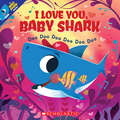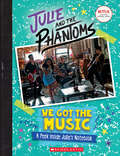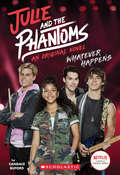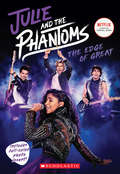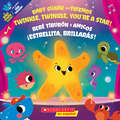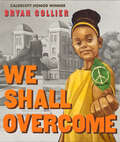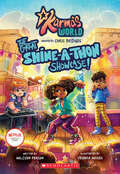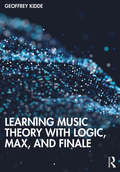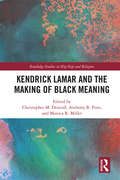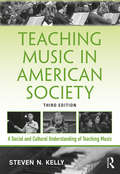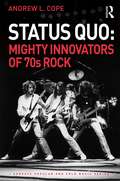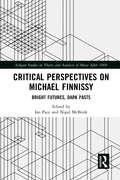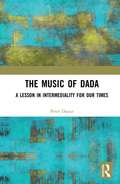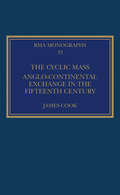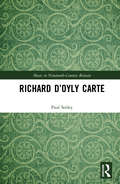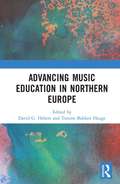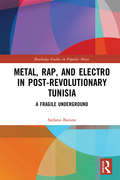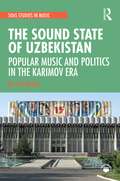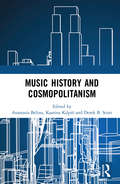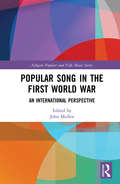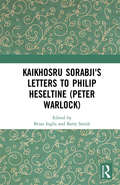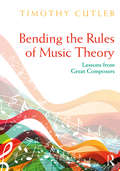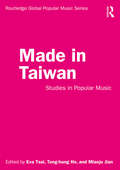- Table View
- List View
I Love You, Baby Shark: Doo Doo Doo Doo Doo Doo (Baby Shark)
by John John BajetSing and dance along with Baby Shark in this story full of kisses, snuggles, and hugs -- the follow-up to the bestselling picture book!How does Baby Shark say "I love you"? No matter where you swim, near or far,My heart will be with you, wherever you are.In the light of day, to the night so dark,I will always love you, Baby Shark!Sing, dance, and read along to this brand-new love-filled song, featuring Baby Shark, Mama Shark, Daddy Shark, and more underwater friends. Perfect for bedtime, Valentine's Day, or any love-filled occasion, Kids and caregivers alike will delight in this silly illustrated story, full of funny, eye-popping illustrations and a catchy tune you won't be able to stop singing. Also features helpful picture guides so readers can dance along, act out the hand and foot movements, and develop their fine motor skills. Snuggle up with your little one and as you laugh, sing, and dance along to this charming and catchy read-aloud!
We Got the Music: A Peek Inside Julie's Notebook (Julie and the Phantoms)
by G. M. KingCheck out Julie and Luke's lyrics, Flynn's gig schedule for the band, and original Sunset Curve memorabilia in this in-world guide to the hit Netflix show Julie and the Phantoms!Julie Molina is always writing in her notebook -- from lyric ideas to memories of her mom, and even plans for her band, Julie and the Phantoms (including words of wisdom like "Make sure no one realizes the guys are ghosts, not holograms").This fun, in-world guide includes notes between Julie and her best friend, Flynn; messy scribbles from Luke, Reggie, and Alex with ideas for new songs (hey, it's hard to hold a pencil when you're dead!); and suspicious theories from Julie's little brother, Carlos, about exactly what's going on out in the garage... Plus, there are full-color photos on every page!Explore all this and more in this exclusive peek at Julie and the Phantoms, the hit new show from High School Musical and Descendants director Kenny Ortega!
Whatever Happens (Julie and the Phantoms, Novel #1)
by Candace BufordJulie and the Phantoms' adventures continue in this original novel based on the hit Netflix show from Descendants director Kenny Ortega!Julie Molina and her band, Julie and the Phantoms, play their dream gig at the Orpheum. It was supposed to be Luke, Reggie, and Alex's unfinished business as ghosts, so they could cross over. But they didn't. And now, suddenly, Julie can feel them.Whatever happens next, Julie and the guys know they've just had one of the best days of their (after)lives. And it gets Luke and Julie thinking about their last perfect days...For Luke, it was the day he died -- the day Sunset Curve was supposed to play the Orpheum. For Julie, it was the day before she found out her mom was sick -- the last normal day before her life changed forever.This exclusive Julie and the Phantoms story is told in flashbacks and alternating points of view!
The Edge of Great (Julie and the Phantoms, Season One Novelization)
by Micol OstowAfter the passing of her mom, Julie has lost her passion for music and is on the verge of being kicked out of her performing arts high school. That is, until she makes the ultimate comeback with her new band, Julie and the Phantoms. There's only one catch: all of her bandmates are ghosts. Back in the 1990s, Luke, Reggie, and Alex were on the cusp of rock stardom with their band, Sunset Curve, before an unfortunate encounter with Los Angeles street food brought their rock band dreamsand livesto an end. Now, with Julie as their lead singer, the guys have a second chance to make it big and to help Julie discover the real power of music. This novel based on season one of the hit Netflix series Julie and the Phantoms is told in alternating points of view and includes exclusive story content not seen on the show!
Twinkle, Twinkle, You’re a Star! / ¡Estrellita, brillarás! (Baby Shark)
by John John BajetDive under the sea to sing and dance with Baby Shark and all his friends, in this underwater twist on a preschool-favorite song all about building confidence!¡Canta y baila con Bebé Tiburón en esta versión submarina de "Estrellita, dónde estás"! Bebé Tiburón y sus amigos le recuerdan a Estrella de Mar todos los motivos por los que es una ESTRELLA, ¡y la animan a compartir su luz, centellear con fuerza y brillar! Con un reparto adorable de personajes submarinos y una variación pegajosa de la popular canción, ¡tu pequeño adorará sumergirse en el mar con Bebé Tiburón!Sing and dance with Baby Shark, in this underwater rendition of "Twinkle, Twinkle Little Star"! With messages of encouragement and confidence-building, Baby Shark and his friends remind Starfish all the ways she is a STAR, encouraging her to share her glow, twinkle boldly, and shine bright! Featuring an adorable cast of underwater characters, a catchy twist on a pre-school favorite song, and a page of stickers, your little one will love diving under the sea with Baby Shark!
Cantaba la rana / The Frog Was Singing
by Rita Rosa Ruesga ScholasticScholastic and Latin Grammy nominee Rita Rosa Ruesga have joined together to bring a wonderful bilingual songbook.¡Las canciones infantiles más populares de Latinoamérica! Con la letra de las canciones en español e inglés, las partituras correspondientes y hermosas ilustraciones, esta colección es una introducción ideal a la rica tradición musical de los países hispanohablantes. A los chicos les encantará.
We Shall Overcome
by Bryan CollierA celebration of the gospel anthem and Civil Rights protest song "We Shall Overcome," masterfully brought to life by Caldecott Honor recipient and a nine-time Coretta Scott King Award winner Bryan Collier."We Shall Overcome" is one of the most recognizable anthems of the Civil Rights movement, widely performed at protests and rallies to promote nonviolent civil rights activism. Now, these inspirational, empowering, legendary lyrics are brought to life with the stirring, evocative, and breathtaking illustrations from multi-award-winning talent Bryan Collier. Powerfully imagined for the present moment, Collier's illustrations meld the most emblematic moments of the twentieth-century Civil Rights movement with the present day, depicting the movements, protests, and demonstrations -- big and small -- as the fight for justice continues. With illustrations full of depth, tenderness, and expression, and offering historical context while remaining powerfully relevant to the present-day, this impactful picture book is a must-have for every home, classroom, and bookshelf.
Karma's World: The Great Shine-a-Thon Showcase
by Halcyon PersonThis brand-new chapter book series follows aspiring rapper and hip-hop artist Karma from the Netflix animated series Karma's World!Meet Karma Grant! Karma and her friends are totally stoked for the MC Grillz concert in their neighborhood, Hansberry Heights! But when the famous rapper's bus breaks down and the show is canceled, it's up to Karma to make the best of some bad luck. Will Karma be able to put on her own concert, the Shine-a-Thon, with her friends or will the pressure prove to be way too much? Filled with heart, humor and Karma's own rhymes, this original chapter book is sure to delight any fans of the show!
Music, Health and Wellbeing
by Naomi Sunderland Natalie Lewandowski Dan Bendrups Brydie-Leigh BartleetThis book explores the power music has to address health inequalities and the social determinants of health and wellbeing. It examines music participation as a determinant of wellbeing and as a transformative tool to impact on wider social, cultural and environmental conditions. Uniquely, in this volume health and wellbeing outcomes are conceptualised on a continuum, with potential effects identified in relation to individual participants, their communities but also society at large. While arts therapy approaches have a clear place in the text, the emphasis is on music making outside of clinical contexts and the broader roles musicians, music facilitators and educators can play in enhancing wellbeing in a range of settings beyond the therapy room. This innovative edited collection will be of great interest to scholars and practitioners of music, social services, medical humanities, education and the broader health field in the social and medical sciences.
Learning Music Theory with Logic, Max, and Finale
by Geoffrey KiddeLearning Music Theory with Logic, Max, and Finale is a groundbreaking resource that bridges the gap between music theory teaching and the world of music software programs. Focusing on three key programs—the Digital Audio Workstation (DAW) Logic, the Audio Programming Language (APL) Max, and the music-printing program Finale—this book shows how they can be used together to learn music theory. It provides an introduction to core music theory concepts and shows how to develop programming skills alongside music theory skills. Software tools form an essential part of the modern musical environment; laptop musicians today can harness incredibly powerful tools to create, record, and manipulate sounds. Yet these programs on their own don’t provide musicians with an understanding of music notation and structures, while traditional music theory teaching doesn’t fully engage with technological capabilities. With clear and practical applications, this book demonstrates how to use DAWs, APLs, and music-printing programs to create interactive resources for learning the mechanics behind how music works. Offering an innovative approach to the learning and teaching of music theory in the context of diverse musical genres, this volume provides game-changing ideas for educators, practicing musicians, and students of music. The author's website at http://www.geoffreykidde.com includes downloadable apps that support this book.
Kendrick Lamar and the Making of Black Meaning (Routledge Studies in Hip Hop and Religion)
by Christopher M. Driscoll Monica R. Miller Anthony B. PinnKendrick Lamar has established himself at the forefront of contemporary hip-hop culture. Artistically adventurous and socially conscious, he has been unapologetic in using his art form, rap music, to address issues affecting black lives while also exploring subjects fundamental to the human experience, such as religious belief. This book is the first to provide an interdisciplinary academic analysis of the impact of Lamar’s corpus. In doing so, it highlights how Lamar’s music reflects current tensions that are keenly felt when dealing with the subjects of race, religion and politics. Starting with Section 80 and ending with DAMN., this book deals with each of Lamar’s four major projects in turn. A panel of academics, journalists and hip-hop practitioners show how religion, in particular black spiritualties, take a front-and-center role in his work. They also observe that his astute and biting thoughts on race and culture may come from an African American perspective, but many find something familiar in Lamar’s lyrical testimony across great chasms of social and geographical difference. This sophisticated exploration of one of popular culture’s emerging icons reveals a complex and multi faceted engagement with religion, faith, race, art and culture. As such, it will be vital reading for anyone working in religious, African American and hip-hop studies, as well as scholars of music, media and popular culture.
Teaching Music in American Society: A Social and Cultural Understanding of Teaching Music
by Steven N. KellyTeaching Music in American Society, Third Edition, provides a comprehensive overview of social and cultural themes directly related to music education, teacher training, and successful teacher characteristics. Music teachers need to be not only knowledgeable in conducting and performing but also socially and culturally aware of students, issues, and events that affect their classrooms. This book is designed for educators seeking K-12 music teacher certification to teach in American schools. At the conclusion of each chapter is a summary of the chapter and a list of key items and people discussed, plus a series of related questions for students to consider. Current topics in the third edition include: • an emphasis on social justice, sensitivity to transgender students, and bullying, • the influences of social media, • a focus on urban music education, and • a new chapter on diverse learning. Further, recent policy issues are addressed in this new edition: • the evolution of the No Child Left Behind Act into the Every Student Succeeds Act, • the increasing emphasis on charter schools, the privatization of public school, • changes in how schools are assessed, and • changes occurring within the teaching profession—and how all of these affect developments in music education. A major structural change is the chapter on equality of education has been split into two chapters, providing a stronger focus on both educational equality and diverse inclusive learning.
Status Quo: Mighty Innovators Of 70s Rock (Ashgate Popular and Folk Music Series)
by Andrew L. CopeStatus Quo were one of the most successful, influential and innovative bands of the 1970s. During the first half of the decade, they wrote, recorded and performed a stream of inventive and highly complex rock compositions, developed 12 bar forms and techniques in new and fascinating ways, and affected important musical and cultural trends. But, despite global success on stage and in the charts, they were maligned by the UK music press, who often referred to them as lamebrained three-chord wonders, and shunned by the superstar Disk Jockeys of the era, who refused to promote their music. As a result, Status Quo remain one of the most misunderstood and underrated bands in the history of popular music. Cope redresses that misconception through a detailed study of the band’s music and live performances, related musical and cultural subtopics and interviews with key band members. The band is reinstated as a serious, artistic and creative phenomenon of the 1970s scene and shown to be vital contributors to the evolution of rock.
Critical Perspectives on Michael Finnissy: Bright Futures, Dark Pasts (Ashgate Studies in Theory and Analysis of Music After 1900)
by Ian Pace Nigel McBrideThe composer and pianist Michael Finnissy (b. 1946) is an unmistakeable presence in the British and international new music scene, both for his immeasurable generosity as prolific composer for many different types of musicians, major advocate for the works of others, and performer and conductor who has also been a driving force behind ensembles; he was also President of the International Society for Contemporary Music from 1990 to 1996. His vast and enormously varied output confounds those who seek easy categorisations: once associated strongly with the ‘new complexity’, Finnissy is equally known as composer regularly engaged with many different folk musics, for working with amateur and community musicians, for a long-term engagement with sacred music, or as an advocate of Anglo-American ‘experimental’ music. Twenty years ago, a large-scale volume entitled Uncommon Ground: The Music of Michael Finnissy gave the first major overview of the output of any ‘complex’ composer. This new volume brings a greater plurality of perspectives and critical sensibility to bear upon an output which is almost twice as large as it was when the earlier book was published. A range of leading contributors – musicologists, composers, performers and others – each grapple with particular questions relating to Finnissy’s music, often in ways which raise questions relating more widely to new music, and provide theoretical foundations for further of study both of Finnissy and other composers.
The Music of Dada: A lesson in intermediality for our times
by Peter Dayan100 years after the Dada soirées rocked the art world, the author investigates the role that music played in the movement. Dada is generally thought of as noisy and unmusical, but The Music of Dada shows that music was at the core of Dada theory and practice. Music (by Schoenberg, Satie and many others) performed on the piano played a central role in the soirées, from the beginnings in Zurich, in 1916, to the end in Paris and Holland, seven years later. The Music of Dada provides a historical analysis of music at Dada events, and asks why accounts of Dada have so consistently ignored music’s vital presence. The answer to that question turns out to explain how music has related to the other arts ever since the days of Dada. The music of Dada is the key to understanding intermediality in our time.
The Cyclic Mass: Anglo-Continental Exchange in the Fifteenth Century (Royal Musical Association Monographs)
by James CookEngland in the fifteenth century was the cradle of much that would have a profound impact on European music for the next several hundred years. Perhaps the greatest such development was the cyclic cantus firmus Mass, and scholarly attention has therefore often been drawn to identifying potentially English examples within the many anonymous Mass cycles that survive in continental sources. Nonetheless, to understand English music in this period is to understand it within a changing nexus of two-way cultural exchange with the continent, and the genre of the Mass cycle is very much at the forefront of this. Indeed, the question of ‘what is English’ cannot truly be answered without also answering the question of ‘what is continental’. This book seeks, initially, to answer both of these questions. Perhaps more importantly, it argues that a number of the works that have induced the most scholarly debate are best seen through the lens of intensive and long-term cultural exchange and that the great binary divide of provenance can, in many cases, productively be broken down. A great many of these works, though often written on the continent, can, it seems, only be understood in relation to English practice – a practice which has had, and will continue to have, major importance in the ongoing history of European Art Music.
Richard D’Oyly Carte (Music in Nineteenth-Century Britain)
by Paul SeeleyThe first biography of Richard D’Oyly Carte, this is a critical survey of the career of the impresario whose ambitions went beyond the famous partnership of Gilbert and Sullivan. Errors and misconceptions in current literature are challenged and corrected to give a truer portrayal of one of the most influential music theatre promoters in the nineteenth century.
Advancing Music Education in Northern Europe
by David G. Hebert Torunn Bakken HaugeAdvancing Music Education in Northern Europe tells the story of a unique organization that has contributed in profound ways to the professional development of music teachers in the Nordic and Baltic nations. At the same time, the book offers reflections on how music education and approaches to the training of music teachers have changed across recent decades, a period of significant innovations. In a time where international partnerships appear to be threatened by a recent resurgence in protectionism and nationalism, this book also more generally demonstrates the value of formalized international cooperation in the sphere of higher education. The setting for the discussion, Northern Europe, is a region arguably of great importance to music education for a number of reasons, seen, for instance, in Norway’s ranking as the “happiest nation on earth”, the well-known success of Finland’s schools in international-comparative measures of student achievement, how Sweden has grappled with its recent experience as “Europe’s top recipient of asylum seekers per capita”, and Estonia’s national identity as a country born from a “Singing Revolution”, to name but a few examples. The contributors chronicle how the Nordic Network for Music Education (NNME) was founded and developed, document its impact, and demonstrate how the eight nations involved in this network – Norway, Iceland, Denmark, Sweden, Finland, Estonia, Latvia, and Lithuania – are making unique contributions of global significance to the field of music education.
Metal, Rap, and Electro in Post-Revolutionary Tunisia: A Fragile Underground (Routledge Studies in Popular Music)
by Stefano BaroneMetal, Rap, and Electro in Tunisia is a trip into the music scenes of Tunisia after the Arab Springs. Based on extensive field research, the book explores the social life of heavy metal, rap, and electronic music in a North African country whose mass revolution of 2010/2011 led the way to a troubled and yet unique democracy. What is it like to be part of a music scene in a place affected by poverty and inequality? How do the many conflicted souls of Tunisian Islam shape local metal, rap, and electro? What are the social and cultural stakes for music in a nation constantly represented as a bridge between Europe and the Middle East? How do music scenes articulate the complex political scenario that followed the Tunisian revolution of 2011? Barone answers these questions by offering new theoretical reflections on youth cultures and popular music in a global perspective, and thus pushing the debate on "post-subcultures" and scenes forward. At the same time, the book offers a dense sociological analysis of youth and music in reality - the Tunisian one - whose society, culture, religion, and politics are at stake in a historical transformation.
The Sound State of Uzbekistan: Popular Music and Politics in the Karimov Era (SOAS Studies in Music Series)
by Kerstin KlenkeThe Sound State of Uzbekistan: Popular Music and Politics in the Karimov Era is a pioneering study of the intersection between popular music and state politics in Central Asia. Based on 20 months of fieldwork and archival research in Tashkent, this book explores a remarkable era in Uzbekistan’s politics (2001–2016), when the Uzbek government promoted a rather unlikely candidate to the prominent position of state sound: estrada, a genre of popular music and a musical relic of socialism. The political importance it attached to estrada was matched by the establishment of an elaborate bureaucratic apparatus for state oversight. The Sound State of Uzbekistan shows the continuing legacy of Soviet concepts to frame the nexus between music, artists and the state, and explains the extraordinary potency ascribed to estrada. At the same time, it challenges classical readings of transition and also questions common binary models for researching culture in totalitarian or authoritarian states. Proposing to approach lives in music under authoritarianism as a form of normality instead, the author promotes a post-Cold War paradigm in music studies.
Music History and Cosmopolitanism
by Anastasia Belina Kaarina Kilpiö Derek B. ScottThis collection of essays is the first book-length study of music history and cosmopolitanism, and is informed by arguments that culture and identity do not have to be viewed as primarily located in the context of nationalist narratives. Rather than trying to distinguish between a true cosmopolitanism and a false cosmopolitanism, the book presents studies that deepen understanding of the heritage of this concept – the various ways in which the term has been used to describe a wide range of activity and social outlooks. It ranges over a two hundred-year period, and more than a dozen countries, revealing how musicians and audiences have responded to a common humanity by embracing culture beyond regional or national boundaries. Among the various topics investigated are: musical cosmopolitanism among composers in Latin America, the Ottoman Empire, and Austro-Hungarian Empire; cosmopolitan popular music historiography; cosmopolitan musical entrepreneurs; and musical cosmopolitanism in the metropolises of New York and Shanghai.
Popular Song in the First World War: An International Perspective (Ashgate Popular and Folk Music Series)
by John MullenWhat did popular song mean to people across the world during the First World War? For the first time, song repertoires and musical industries from countries on both sides in the Great War as well as from neutral countries are analysed in one exciting volume. Experts from around the world, and with very different approaches, bring to life the entertainment of a century ago, to show the role it played in the lives of our ancestors. The reader will meet the penniless lyricist, the theatre chain owner, the cross-dressing singer, fado composer, stage Scotsman or rhyming soldier, whether they come from Serbia, Britain, the USA, Germany, France, Portugal or elsewhere, in this fascinating exploration of showbiz before the generalization of the gramophone. Singing was a vector for patriotic support for the war, and sometimes for anti-war activism, but it was much more than that, and expressed and constructed debates, anxieties, social identities and changes in gender roles. This work, accompanied by many links to online recordings, will allow the reader to glimpse the complex role of popular song in people’s lives in a period of total war.
Kaikhosru Sorabji's Letters to Philip Heseltine (Peter Warlock)
by Barry Smith Brian InglisTwo extraordinary personalities, and one remarkable friendship, are reflected in the unique corpus of letters from Anglo-Parsi composer-critic Kaikhosru Sorabji (1892-1988) to Philip Heseltine (Peter Warlock) (1894-1930): a fascinating primary source for the period 1913-1922 available in a complete scholarly edition for the first time. The volume also provides a new contextual, critical and interpretative framework, incorporating a myriad of perspectives: identities, social geographies, style construction, and mutual interests and influences. Pertinent period documents, including evidence of Heseltine’s reactions, enhance the sense of narrative and expand on aesthetic discussions. Through the letters’ entertaining and perceptive lens, Sorabji’s early life and compositions are vividly illuminated and Heseltine’s own intriguing life and work recontextualised. What emerges takes us beyond tropes of otherness and eccentricity to reveal a persona and a narrative with great relevance to modern-day debates on canonicity and identity, especially the nexus of ethnicity, queer identities and Western art music. Scholars, performers and admirers of early twentieth-century music in Britain, and beyond, will find this a valuable addition to the literature. The book will appeal to those studying or interested in early musical modernism and its reception; cultural life in London around and after the First World War; music, nationality and race; Commonwealth studies; and music and sexuality.
Bending the Rules of Music Theory: Lessons from Great Composers
by Timothy CutlerFor students learning the principles of music theory, it can often seem as though the tradition of tonal harmony is governed by immutable rules that define which chords, tones, and intervals can be used where. Yet even within the classical canon, there are innumerable examples of composers diverging from these foundational "rules." Drawing on examples from composers including J.S. Bach, Mozart, Beethoven, Schubert, Mendelssohn, Chopin, Brahms, and more, Bending the Rules of Music Theory seeks to take readers beyond the basics of music theory and help them to understand the inherent flexibility in the system of tonal music. Chapters explore the use of different rule-breaking elements in practice and why they work, introducing students to a more nuanced understanding of music theory.
Made in Taiwan: Studies in Popular Music (Routledge Global Popular Music Series)
by Eva Tsai Tung-Hung Ho Miaoju JianMade in Taiwan: Studies in Popular Music serves as a comprehensive introduction to the history, sociology, and musicology of contemporary Taiwanese popular music. Each essay, written by a leading scholar of Taiwanese music, covers the major figures, styles, and social contexts of pop music in Taiwan and provides adequate context so readers understand why the figure or genre under discussion is of lasting significance. The book first presents a general description of the history and background of popular music in Taiwan, followed by essays organized into thematic sections: Trajectories, Identities, Issues, and Interactions.
